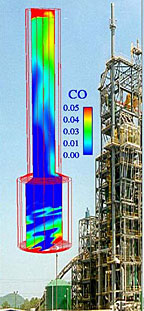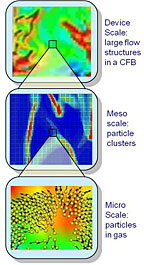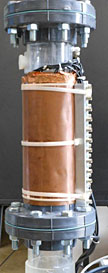- Number 358 |
- March 12, 2012
Modeling multiphase systems at NETL

MFIX simulation with
KBR gasifier.
Fluid dynamics is the study that leads to automobiles with less drag in traveling through surrounding air, and to airplane wings that lift when air flows around them. Because many industrial processes employ moving fluids (gases or liquids), understanding the physical behavior of such systems can assist in the design of new and/or more efficient processes. To do that, engineers have developed a mathematical (computational) approach called computational fluid dynamics (CFD) to simulate the physical reality of these systems with the goal of improving industrial processes that employ moving fluids.
Describing flow is more challenging for solids than for liquids or gases. Can you pour potato flakes (or pancake mix) out of the box without plugging the spout? An engineering study showed that solids processing plants typically achieve only 64% of their design capacity while plants designed to use gases or liquids typically achieve 90-95% of their design capacity. Thus, granular solids (solids that flow or are fluid) require special treatment.
While typical CFD software solves Reynolds Averaged Navier-Stokes time-averaged equations of motion to describe the flow of fluids, some CFD software packages add the capability of describing solids motion when a large number of particles tend to behave like a fluid (or continuum) at a certain scale. Scientists at DOE's National Energy Technology Laboratory have developed an open-source software product called MFIX (Multiphase Flow with Interphase eXchanges) that also describes the flow of individually distinct or discrete particles. Using the discrete approach, individual particles are discernible and their motion and collisions with other particles are tracked. The discrete approach is valid under all conditions, but is prohibitively expensive for industrial reactors where trillions of particles are present (dense regime). The continuum approach is cheaper, but not as accurate when the number of particles per unit volume is small (dilute regime). Both dense and dilute regimes are present in some industrial reactors, so the MFIX capability for describing solids as a continuum as well as discrete particles provides a powerful and widely applicable multiphase CFD framework.

Levels of averaging: discrete
particles to continuum to
filtered-continuum models.
When add-on modules for modeling chemical reactions are incorporated in MFIX, engineers are able to simulate a wide variety of systems including advanced combustion systems, coal gasification, absorbers for controlling pollutants, polyethylene production, methanol synthesis, synthetic fuel manufacturing, silicon production, refinery operations, nuclear fuel preparation, dust explosions and lava flow from volcanoes. With other specialized modules, MFIX could model processes NASA would need to design plants for converting resources indigenous to the Moon and Mars into fuel or oxygen or both. Developing these add-on modules is facilitated by the open-source nature of MFIX, which allows collaborators in industry and academia to join in improving the code in both scope and accuracy.
For highly complex multi-phase processes, executing the simulation requires more computer power than is often available or practical. To overcome these obstacles, engineers develop reduced order models that break the computational problem into smaller units called cells. The simulations for individual cells are calculated simultaneously on more affordable and easily constructed computer systems or clusters running in parallel until the solutions for all cells converge.

Determining particle
location and trajectory.
Among the approaches for doing this is high-speed electrical capacitance volume tomography (ECVT) developed in cooperation with NETL by researchers at Tech4Imaging and Ohio State University. Using simple equipment that can be mounted non-intrusively in various geometric configurations, the system senses electrical capacitance at high speed as a measure of solids velocities and concentrations across an entire flow volume. High-speed computers processing the data render a three-dimensional image of the particle concentration and flow inside the observed volume. The system will be useful in validating computational modeling software, such as MFIX, by providing real time solids flow data for comparison with model predictions.
[Linda Morton, 304.285.4543,
Linda.morton@netl.doe.gov]
